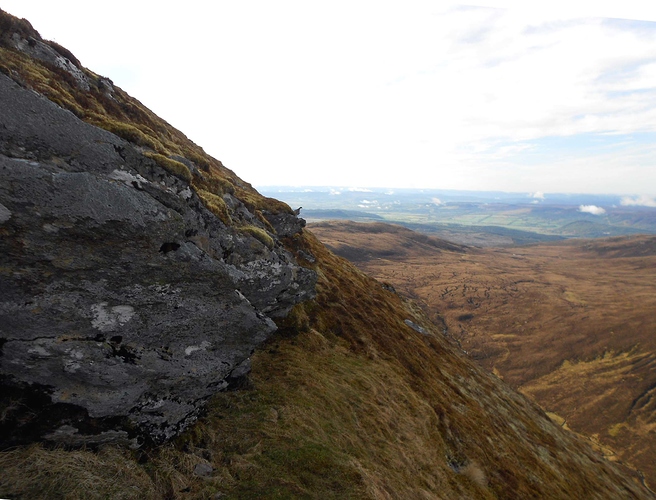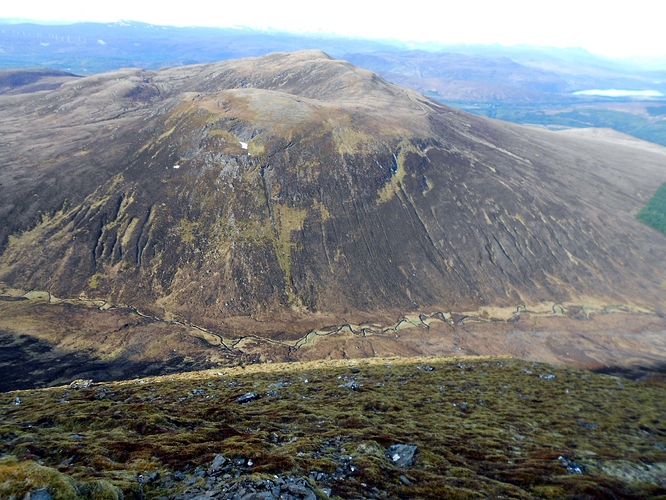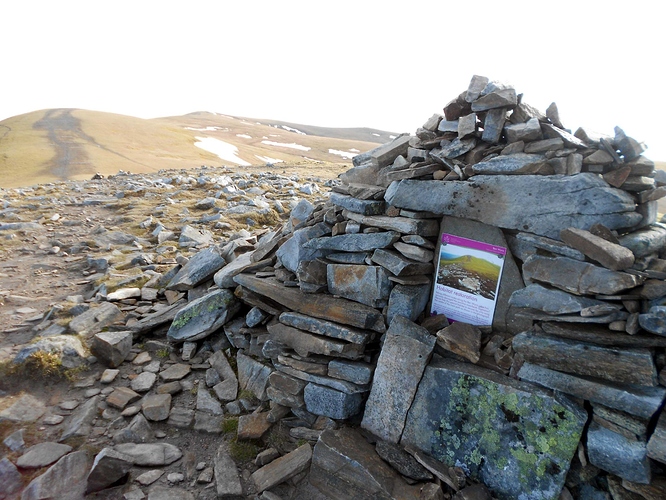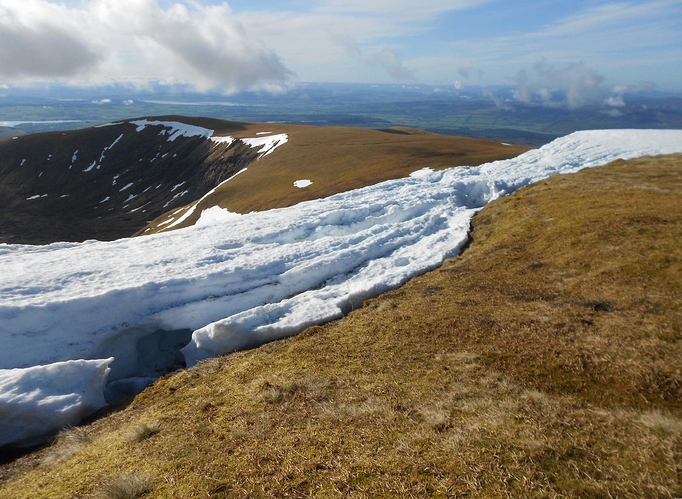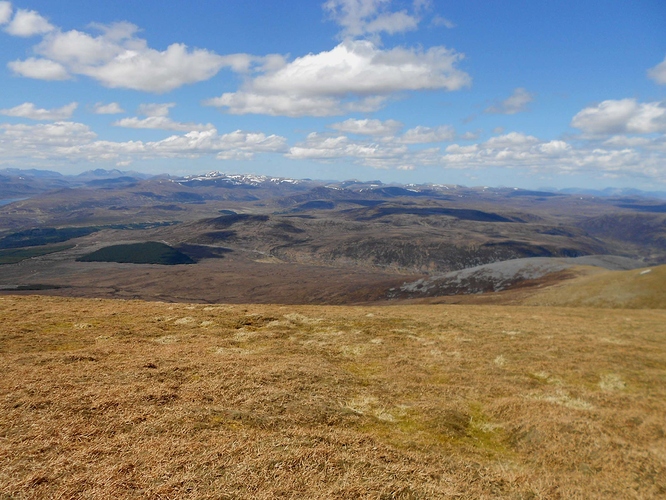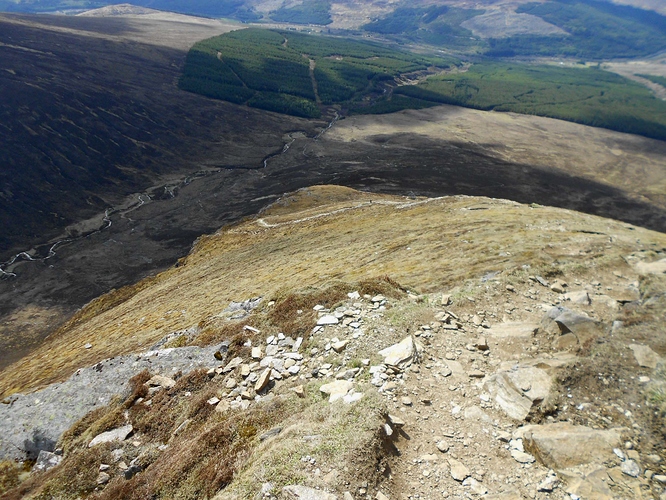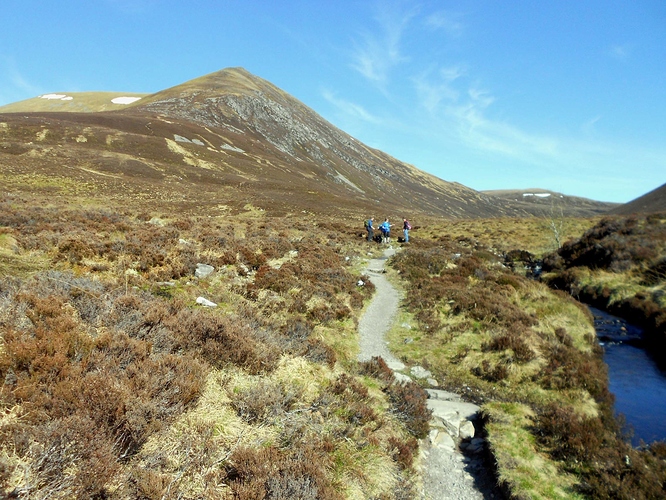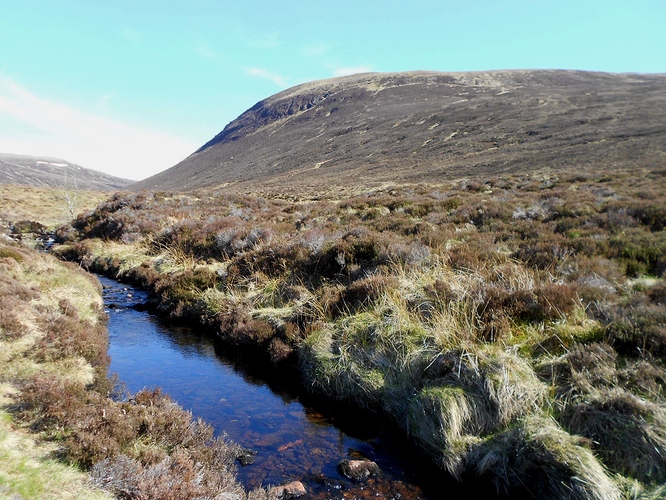G4YSS Activation Report, GM/NS-005 on 12th May 2018.
Issue-1
BEN WYVIS (Glas Leathad Mor) GM/NS-005
G(M)4YSS/P using SSEG Clubcall GS0OOO/P
HF QRO on 160-80-60-40-20m & 2m-FM QRP
All times: BST (UTC plus 1hr UOS as ‘z’)
Unaccompanied
This activation was part of our May 2018 seven-day self-drive holiday based at Shearing’s Highland Hotel, Strathpeffer. Ben Wyvis was summit 2 of 2. (For 1 of 2 - Ben Macdui link, see foot of report)
EQUIPMENT:
FT817ND HF/VHF/UHF 5W Transceiver
MX-P50M, 50 Watt HF Linear Amplifier (80 thru’ 10 with 160m capability)
Link dipole for 80-60-40-(30)-20m on a 5m CFC mast with 1m end-sticks
Loading coils for 160m at 40m break points
One 5 Ah Li-Po battery
J-Pole for 2m FM
Reserves:
UV-5R 2m/ 70cm 5W Handie (after failure of IC-E90 on previous activation)
UV-3R 2m/ 70cm 2W Handie carried in top pocket
QRO pack: 10kg (22 pounds) including food, Primaloft jacket, 1 litre drinks
INTRODUCTION:
Having had a successful activation of Ben Macdui 2-days prior and knowing that this would likely end up as a two activation week, I was looking for another sizeable hill to lavish my attention on.
Ben Wyvis is handy for the hotel (unlike the previous summit Ben Macdui - ES1) and has an excellent path, with steps on the steeper sections. On the negative side, more ascent is required to knock this one off than ES1 because of the start point, which is only 144m (472ft) as opposed to a massive 635m (2,037ft) for ES1. After a gentle start the path is generally steeper, especially when climbing the 946m intermediate high point of An Cabar. It’s much higher but Ben Wyvis has much of the appearance of a G/NP because of its grassy summit.
Having done this one, along with its near neighbour Little Wyvis, on 10th October 2012, I knew exactly what to expect and the resultant well-marked GPS route eliminated all concerns about way finding.
EXECUTION:
For the second time, the hotel’s night porter sorted out cereal, tea and toast for me, this time an hour later at 05:30 and I was away for 05:55. Also for the second time this week, Ray GM3PIL answered an early morning call on 145.575-FM from his QTH at Piper Hill (nr Nairn). A conversation resulted until I lost him near Garve. I was able to tell him that I might be late on the air, after realising that I’d posted the wrong alert times on Sotawatch. However an earlier than planned start and a steady ascent ironed this out.
The drive to the Ben Wyvis car park (NH4104 6713) on the A835 Ullapool road, took just 20 minutes to 06:15 and I was able to get walking in still conditions at 06:31. There was a car with a small tent beside it plus a camper van there when I arrived. I tried my best not to wake up the sleepers.
Route:
From the start at NH4104 6713 the path parallel’s the road NE for about 300m before passing over a footbridge and through a gated deer fence at NH 4123 6734. This is where the climbing begins as you pass through a forested area, crossing over a forest track at NH 4172 6720 then on via NH 4223 6696 and NH 4313 6652 beside a stream, at which point the trees are left behind.
From there it’s simple to follow up the east ridge of An Cabar on a steep but well surfaced zig-zag path via NH 4358 6670 and NH 4398 6665; finally arriving at the 946m minor summit.
The path splits at NH 4435 6651; where I opt for the left turn and the gradient finally eases at NH 4460 6655. After passing a notice on the An Cabar summit cairn, which refers to path wear, it’s just a matter of walking along the undulating grassy ridge on a stony path to the 1,046m high point called Glas Leathad Mor, which was attained by 08:39. The shelter surrounding the trig point was GPS’d at NH 46299 68374 back in 2012.
I walked along the summit ridge in sunshine, while talking to GM3PIL on the 2-Watt handheld. Upon reaching the trig point we exchanged reports again to make the first contact of the activation. I think Ray gave me at least 59 plus 30dB – line of sight at 40km range. The remnants of winter were impressive; a deep bank of snow overhanging the eastern edge for quite a way. It will still be there weeks from now.
Ascent time was 2hr-8min. (See ‘Descent’ section for minor detour which avoids the top of An Cabar)
BEN WYVIS, GM/NS-005, 1,046m, 8 pts, 08:39 to 15:40. Wind less than 3mph at start, increasing gradually to 15 mph after noon. Temp 5 deg C and rising. Mostly sunshine. Massive snow cornice along the east edge. LOC: IO77RQ, WAB: NH46, Trig: TP-1312. Phone: Almost Nil Vodafone signal. (I had full EE (Orange) Mobile phone coverage in 2012).
Views were excellent in all directions and alien looking oil rigs could be seen in the Cromarty Firth. A favourite of mine; An Teallach was also visible to the west. I set up the dipole about 30m NE of the trig, then fitted and tuned the Top Band loading coils so as to make the QSY to 160m much quicker later on.
145.575 FM – 4 QSO’s:
To save the main battery, the UV-5R was coupled to the J-Pole for 2m and the appropriate warnings issued! I didn’t have my IC-E90 four-bander, which had failed to ‘light up’ on Ben Macdui 2 days before.
After a tip-off to Ray GM3PIL (who had been worked on arrival) that 160m would follow shortly, I worked Bob MM3ZRF in Alness. 55 both ways. Andy GM0UDL came up and was next in the log at 59 both ways (QTH nr. Fortrose on the Black Isle). The final station worked on 2m was MM0EFJ Mike at Dingwall also with 59 reports. A good start with 5 Watts to a vertical and the UV-5R appeared to work faultlessly. If the HF gear failed now, at least we were qualified. There was a fifth 2m-FM QSO. (See below)
1.832 CW – 1 QSO:
Arranged with 2m-FM talkback, I worked Ray GM3PIL with 599 both ways. Ray’s was the only chase on 160m and we failed to repeat it on SSB for some reason. I could hear Ray at 51 but he wasn’t hearing me well enough for intelligibility. This vast difference between the two modes, Ray and I have seen before but the reason is unclear. I believe that Ray tuned up a 40m dipole for this QSO.
3.557 CW - 1 QSO:
The first thing I did after checking the VSWR was to call G4SSH. I was almost certain that Roy would be listening but after several attempts there was nothing. What a marked difference in band conditions from two days previously when Roy’s 80m CW signal had done its best to split my eardrums.
Despite being just about on time with regard to the alert, I only managed to raise one person on here, namely Ray GM3PIL who wanted to bag NS5 on 80. Reports were 599 both ways but another five minutes of 30W (and later 50W) CQ’s until 08:55z, brought nothing further.
3.760/ 3.763 SSB - 12 QSO’s:
After Ray GM3PIL called in for a place in the SSB log, I worked MM3PDM Peter in Peterhead. Next in was Phil G7AFM with 52/ 44 and a rather difficult QSO. Phil kindly put a spot on Sotawatch for me and that brought in a few more.
From this point I worked: M3FEH Karl in Cornwall; G0FEX Ken in Leicester; G0VWP Terry at York; GI0AZA Esther & GI0AZB Ian - Londonderry; GM4WHA Geoff - Annan; GM4NFI Dave in NN07; EI3GYB Michael in Mayo and GM0AXY Ken – Edinburgh. I tried my best to work Geoff G0GWY but he couldn’t get the report. In the end we had to give up.
Peter was running the show at the time and my offer to QSY ‘3 up’ was accepted. It made sense. Peter could carry on listening for WAB mobiles while I worked SOTA and WAB a channel higher. Somehow we lost PA0SKP in the QSY, despite Peter having sent Sake up to my channel. Maybe I just faded out in the QSB?
Power was 30 Watts and reports were only moderate – around the 55 to 57 level outgoing but many coming back with 44’s and 55’s. The session took 35 minutes.
Ray GM3PIL who had been 599 both ways on 80m-CW now gave me a 43 report on here. Ray was 58 on my meter. Here again was demonstrated a vast difference between the two modes, as was the case on Top Band. This only seems to apply to Ray as nowadays, I seem to log twice the number of stations on 160m SSB as on CW and with similar ease (or the lack of it). Maybe Ray has a particular sort of local noise that disproportionately affects SSB. That’s natural due to the filters employed for the two modes and the amount of band noise they let in but this situation seemed worse than normal.
7.033.3/ 7.031.3 CW - 11 QSO’s:
After a few calls of ‘G4SSH?’ followed by blind CQ’s on here I gave up in favour of trying to obtain a spot. Every time I tried to text Roy G4SSH the phone came up with, ‘Message Failed.’ Every time I phoned him, just strange beeping sounds and then it cut off. I called Ray on 2m and he had a spot on in quick time. Good job too but I still lost my 7.033 channel which forced me down the band a little way.
Following another quick QSO with Ray and 599 both ways again, I was able to log an extremely slow trickle of stations on the new frequency, many of them chasers: G3XIZ; OZ7JZ; DJ5AA; PA0B Rob; G3RMD (Frank who’s callsign I minced); OH3GZ; OH6RP; G4WSB Bill; 9A6CW/P – S2S on 9A/DH-041 and DK2JK. Believe it or not, this took almost an hour.
Reports were averaging 569 going out but there were quite a few readability fours coming back in. I don’t know what happened to DL2DXA/P. Bernd, presumably on a summit, called in at 579 but then abruptly disappeared before we could get the S2S particulars over but I don’t think it was down to QSB. He doesn’t appear on the spots so maybe I mistook him for someone else. A mystery.
Conditions must have been somewhat poor. I had been on the summit for over three and a half hours with just barely a page of log to show for it. Good job there was plenty of time to spare and good weather.
145.575 FM – 1 QSO:
In the middle of the above 7MHz CW session I heard a caller on the handheld. This was 2E0JAT Sandie in Inverness and we exchanged 59’s. Afterwards I directed him to Ray, who was standing by on the frequency, for them to have a chat.
7.155/ 7.138 SSB - 2 (GB) QSO’s:
After CW , I went directly to 7.160 but it was occupied. Andy GM8OEG/P was working from GM/ES-048 at the time but at only 130km away, he was too close to resolve and I couldn’t work him. I thought of calling in to see whether a net controller might pick me up but there was more than enough traffic on there already.
I spent the next hour having lunch and twiddling around the 40m SSB band, working a couple of special even stations on the way. These were: GB2RAF - permanent GB station at RAF Neatishead in Norfolk and operated by Terry and GB5WEM - The Bittern DX Group, windmill and windpump specialist activators. I spoke to Linda who mentioned Repps, which I think was her QTH in Norfolk. This was all well and good and a nice way to pass the lunch break but as far as SOTA chasers were concerned, I’d emigrated.
14.052.6 CW – 6 QSO’s:
The alerted time for 20m was now upon us. Time to see what, if anything, could be done there. I worked Ray GM3PIL with 599’s again plus DL5AWI Gerd (599/ 579). A few CQ calls later and the frequency was lost to another, more powerful CQ’er. C’est la vie.
Time to call Ray on 145.575-FM and ask for a spot. One was provided, this time on 14.054 and there rapidly followed: DL1FU Frid 579/ 449; OK2PDT Jan 599 both ways; F6FTB Christian 569/ 549 and GM0UDL – Andy back in the shack on the Black Isle with a very strong signal.
The 50 Watt session took from 12:12 to 12:35z. The rig cut out one QSO from the end due to the main 5Ah battery giving up. Once the reserve 2.2Ah Li-Po was connected, we were back in business and free from worry about further power failure. There wasn’t enough time left for that.
14.285 SSB – 14 QSO’s:
I tried my best to avoid calling GM3PIL on 2m-FM again for a spot but when no one came back to my CQ’s, the temptation became too great. I was glad I did because Ray’s spot for this session got me the most QSO’s of any.
Stations worked with 50 Watts were: OE5HDN Heinz; OH3GZ Jukka; S59DXX (Maribor Radio Club); S57ILF Franci; S51RU Marjan; EA2DT Manuel; EA2CKX Pedro; OK7WA Frantisek; LY1NDN Viktor; DD6DO Stephan in Berlin; IZ2KWS Matt; IW4BLZ Maurice; G0FEX Ken in Leicester and GM3PIL – Ray sneaking in at the end for his 6th and final band/ mode ‘multiplier’ of the day with a report of 59 plus 30dB.
Outgoing reports were mostly 57 with two 58’s and a 59. Coming back were readability 5 reports with 4’s from Spain, Berlin and G0FEX Ken in Leicester. Fading featured big. Typifying conditions, Manuel gave me a ‘44 to 57 QSB’ report.
7.160 SSB - 7 QSO’s:
With SOTA, WAB square and Trig Point to offer, I wasn’t about to quit before trying this frequency. Busy earlier, it seemed clear now so I tried a CQ, getting back Ken G0FEX with a 59/ 57 exchange. Next came an S2S with Caroline MI3ZCB/P. Caroline’s ‘OM’ Martyn MI1MAJ/P quickly followed to tell me I’d worked GI/AH-006. Reports were 55’s and a 44.
After this early success there were four more callers: 2E0WDX/M Vin in Newcastle; G8ADD Brian in Brum; G0RQL Don in Devon and finally G8VNW Nick – an enthusiastic 160m SOTA chaser, at Threshfield in the Yorkshire Dales.
Reports for the last four QSO’s were were 57/ 57 to 59 QSB. 58/ 45. 55/ 35. 57/ 58 to 47 QSB respectively and power was 50 Watts again.
At this point a strong station F5PAU jumped onto the frequency. No matter how hard I tried I couldn’t shift him. He seemed to be talking to other ‘F’ stations in their own language. OK thought I, if you can’t beat 'em join 'em but this wasn’t a success either. Every time I called him in to work the SOTA he didn’t respond. Instead of the traditional ‘QRT’ I just announced ‘I give up’ and QSY’d to 60m. I didn’t let it affect my sense of humour however. Ray GM3PIL heard all this and commented about it on 2m-FM afterwards.
5.381.5 CW – 1 QSO:
After nearly seven hours, there had been no sign of my pal G4SSH on any frequency I’d been on. With minutes left before packing up and battery reserves unknown, I set about the task of trying to rectify this problem. I hoped that asking Ray to post me on the 60m CW frequency might just bring Roy in but it didn’t. However this wasn’t a wasted effort because I did work G0FVH Dave in Poole with 559 both ways. Poole is three hundred and thirty km further away than Scarborough so I didn’t hold out much hope of getting Roy in the intervening skip zone.
It was then I had a bit of luck. After many attempts to text or phone Roy and my XYL throughout the day had ended in failure, I was surprised to see a Vodafone signal. All I had managed in 7 hours was little more than a quick, ‘I’m OK’ to my XYL before being cut off. Roy and I managed a short conversation and he suggesting 3.557-CW if 60m proved no good. Though I could hear Roy calling at 559 on 5.381.5, he wasn’t hearing me at all. This was going right down to the wire but hopefully 80m would provide the solution.
3.557 CW – 1 QSO:
Finally at 14:18 UTC, I logged Roy G4SSH. He came in at 599 but dropped to 559 in QSB. Roy gave me 229 and the job was done. Last contact of the day.
Lost Glove:
Since arriving at 08:39, the wind had increased in strength from under 3mph to nearer 15 or 20. For the latter part, equipment like sit-mat, logs etc. needed to be weighted down if left unattended. This is when I found that a fingerless glove had somehow migrated out of my pocket and must have blown away but a search revealed nothing. This just adds to a list of small items that I have managed to lose over the last year or two; the most regrettable being a Petzl Zipka Plus headlamp which I can’t replace. I don’t know why they stopped making this model just to replace it with something less useful, at least to me. It had a lovely bright and even spread beam using 4 LED’s. It was light, compact and had a great battery life. Product improvements can never be taken for granted, it would seem.
THE DESCENT (Inc. Short Detour):
I couldn’t resist picking up a few small samples as I walked along the summit ridge while talking to Ray on 2m. Garnet Mica Schist; a metamorphic rock is very attractive when the sun is on it. I got a piece last time and you could see tiny garnets in it.
I’d intended a straight reverse of the ascent route until I discovered a short cut around the top contours of An Cabar. Having walked via An Cabar’s summit three times, I have no idea why I hadn’t seen this before but it isn’t that obvious unless you are returning to the right of the ridge top/ centre line. The detour saves just under 100m of walking and 12m of ascent both on the ascent and on the descent. A total of 200m and 24m for the expedition. Not much but every little helps, even though most of this sort of thing is psychological.
The path is well used, straight and easy to follow. Way points (in order of ascent) for this short-cut are as follows: NH 44784 66539; NH 44829 66553 (paths diverge); NH 44908 66619; NH 45041 66734; NH 45151 66871 and NH 45253 67093 (main ridge).
The lower part of the descent wasn’t comfortable. The strong, cooling wind on the summit decreased on the way down and sultry heat took over. To be fair that’s an exaggeration but it doesn’t take much for me to overheat; the reason why I like winter walking best.
I was too lazy to stop and put the fleece in the rucksack and so suffered to the end, entering the car park at 17:21. There are a lot of steep steps on the eastern aspect of An Cabar which meant a slow descent time of 1hr-41min. The drive back to Strathpeffer took from 17:25 to 17:45.
Ascent & Distance Walked:
Car Park to NS5 Ben Wyvis: 935m ascent / 7.5km
NS5 Ben Wyvis to Car Park: 10m ascent / 7.4km
TOTAL ASCENT & DISTANCE: 945m (3,100ft) / 14.9km (9.3 miles)
CHRONOLOGY:
Up at: 05:15.
Left Strathpeffer: 05:55
Arrived Ben Wyvis Car Park: 06:15
Walk started: 06:31 (via An Cabar)
GM/NS-005: 08:39 to 15:40
Returned Ben Wyvis Car Park: 17:21
Back to Strathpeffer: 17:45
Walking time: 3hr-49 min (2.4mph)
Summit time: 7hr-9 min.
Gross time Car to Car: 10hr-50 min
QSO’s:
1 on 160m CW
0 on 160m SSB
2 on 80m-CW
12 on 80m-SSB
1 on 60m-CW
11 on 40m-CW
9 on 40m-SSB
6 on 20m-CW
14 on 20m-SSB
5 on 2m-FM
TOTAL: 61
SOTA Activator points: 8
S2S’s: 3
COMMENTS:
Yet another holiday in Scotland. We must love the place! For the umpteenth time Shearings provided comfortable accommodation, though on occasions it has been Lochs and Glens. The staff at the Highland Hotel, Strathpeffer are efficient and above all friendly Katherine is still in charge if the dining room and Gabriel, the night porter, cheerfully provided very early breakfasts on the two operating days. Unlike 2012 when there was none, the hotel now has Wi-Fi but only in the foyer. Much better than nothing, this enabled alerts and emails.
With six days available, I should have been able to put three summits on the air but the first two days were unsuitable weather wise, especially for going high. The result was just two summits activated. Ben Macdui was a special treat which brought back loads of memories, camping up there with my two sons 25 years ago. Looking at the record, it seems that Barry GM4TOE has activated it the most.
As Munros go, Ben Wyvis is a simple one without any danger or route issues involving scrambling etc. Wayfinding is straightforward - you just follow the path through the trees and up the steps. Grass at the top makes antenna erection easy. Little Wyvis, added to the round in 2012, was left out this time. The trackless waste between it and Ben Wyvis, which more than doubled the workload then, rather put me off this time. Much better to spend hours and hours on one summit for a thorough multiband QRO activation rather than the rushed two-summit QRP of 2012.
Band conditions were pretty poor with a lot of QSB but they were by no means unworkable, especially with 50 Watts available. However, the unexpected lack of Vodafone coverage and the absence of my EE phone, which failed days before the holiday, were serious drawbacks. It meant that I couldn’t enjoy the smooth support and SOTA related advice that Roy G4SSH normally gives me. Nor could I employ my newfound skill of self spotting. I fought shy of pestering Ray GM3PIL for spots but on the one hand he seemed willing and on the other I gradually became more desperate. In the end Ray saved the day and I got 61 QSO’s on nine frequencies including one on 160m – Ray himself.
61 QSO’s in seven hours doesn’t sound a lot but it wasn’t bad considering at best, the mediocre HF band conditions. Besides, deciding against adding NS50 gave me so much time, it began to feel more like a picnic that a SOTA activation. Added to that was the complete lack of threat from the weather. Something you don’t often get at three and a half thousand feet.
160m:
Ray GM3PIL managed it in CW but unfortunately Andy GM0UDL missed my brief appearance there. Other than prearrangement with local stations The only way to get SOTA contacts on 160m in northern GM, especially in daylight, is to either beg via a repeater during the activation or ask any ops worked on 2-FM if they have the capability for 160. Most don’t but both these methods have been successful in the past. It’s been a long time in coming but having the 160m MG cert finally in my possession, makes me not so desperate these days. That doesn’t mean I don’t still love the band. Nor does it mean I won’t be putting it on in the future (all being well that is).
General:
I can recommend the welcome that visiting amateurs get on the 145.575-FM Inverness chat channel. Local knowledge and great support was forthcoming and Ray GM3PIL really helped with spotting my QSY’s this time. I’m only sorry he missed a nice sunny day sitting inside when he could have been out in the garden! It was a pleasure to work Andy, Bob, Mike and Sandy on there too.
The IC706-2G installed in my wife’s car was only used on 145.575 VHFM this time but it wasn’t for the want of trying on HF. On the days I wasn’t doing SOTA, I tried calling on 3.760 and 7.160 WAB frequencies without success and even devised a GPS route with a view to putting on NH24 portable square. It was unfortunate that the mag-mount blew off on the A1M on the way up. It put some nasty scratches on the roof and door. I blame the sunspot cycle for this. The 80m whip has twice the windage of the 40m one.
Recorded in the mobile log are a three more callsigns, namely GM6ZAV/P - Andy who I worked from the A68 on the way up to Scotland. Andy was on SOTA GM/SS-198. He was 59 plus to me but was not receiving me too well. A little later I worked GM8ARV David, who kept me company around the Edinburgh A720 ring road, ensuring we got to the right bridge which is named the Queensferry Crossing. After watching it being built over the past few years, it was great to drive along this elegant structure for the first time. It’s a triumph of civil engineering that you can’t help but admire, as well as being easy on the eye.
On the journey back home I worked G1XYS Allan on 145.400-FM from the A697 north of Newcastle. Allan is a good friend of Jim G0CQK and we had a good conversation about VHF, beams and the 4m band.
We always break the journey at the Cafe at Milfield, just south of Coldstream on the A697. They are open 07:30 (8am on Sundays) to 18:00, 364 days a year.
THANKS:
To ALL STATIONS worked. To GM3PIL Ray for his on-air spotting service, 160m QSO and to G7AFM Phil. Apologies to Roy G4SSH, waiting patiently for a phone call that almost never came. Not that they’ll ever read it but thanks to the Highland Hotel, Strathpeffer for comfortable accommodation at £34.70 pppn for DBB (up from £24 in 2012). Finally to my XYL for the use of her once posh but now scratched Citroen C4 Picasso (982 miles at 62.7mpg). T-Cutt should fix most of the damage (I hope!)
73, John G4YSS
Using Scarborough Special Events Group Club call GS0OOO/P
For Ben Macdui - GM/WS-001 on 10-05-18, report see: G4YSS: GM/ES-001 Ben Macdui,10-05-18
////////////////////////////////////////////////////////////////////////////////////////////////////////////
Photos: 2-5-8-17a-20a-29-34-46-47-61-63-71-75a-86-87-102a-107a-108a
Above: Ben Wyvis Car Park at 06:30
Above: Ben Wyvis Car Park at 06:30. Information board
Above: Ben Wyvis path. Intermediate high point An Cabar ahead
Above: Ben Wyvis path. Climbing An Cabar. A Grouse.
Above: Looking across to Little Wyvis (GM/NS-050) from the side of An Cabar. This time I declined to add NS50 because of the difficult intervening ground and lack of direct path.
Above: Intermediate high point An Cabar 946m (3,104ft). The target - Ben Wyvis ahead.
Above: Looking in a southerly direction from the Ben Wyvis ridge.
Above: Looking back along the Ben Wyvis ridge path towards An Cabar.
Above: The Ben Wyvis Trig Pillar TP-1312
Above: Activation of GM/NS-005 Ben Wyvis on HF
Above: Trig Point and activation of GM/NS-005 Ben Wyvis on HF
Above: Activation of GM/NS-005 Ben Wyvis on HF
Above: GM/NS-005 Ben Wyvis. Activation clutter. Light wind condx. only.
Above: Summit of Ben Wyvis. Evidence of vehicles
Above: Summit of Ben Wyvis. View north of west. An Teallach?
Above: Summit of Ben Wyvis. Substantial eastern edge snow-field
Above: Summit of Ben Wyvis. Substantial eastern edge snow-field & trig pt.
Above: Path down An Cabar and a walker descending. Path then follows valley through trees. Car park top centre (not visible)
Above: Ben Wyvis path. Looking back at An Cabar. NS50 out of shot to right
Above: Ben Wyvis path. Lower slopes of Tom na Caillich (705m) a sub-summit of Little Wyvis, GM/NS-050. Stream is called Allt a Bhealaich Mhoir
